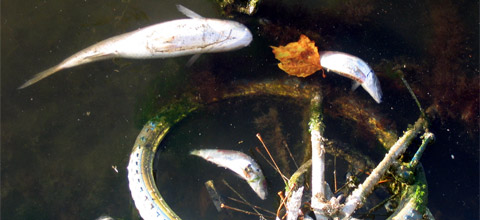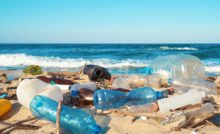

How is it that the quality of water in nature (but also that we consume) will be so degraded ? Who to blame ? What are the consequences for our health and our environment ? Global warming affects the quality of the water ?
The facts
D’après l’étude de l’ASEF (Health environment France Association) from 2010, 10% surface waters of the France (rivers, rivers, Lakes, etc.) are without pesticides, 27% are poor to average and 10% are of very poor quality. 53% groundwater (groundwater), pesticides and 24% require special treatment before being consumable.
Who to blame ? And what are the consequences ?
1) Agriculture
Intensive agriculture requires large amounts of fertilizer (nitrates, phosphorus, etc.), of pesticides (herbicides, insecticides, fungicides) that contaminate the environment (soils, water courses, etc.). The France is the first European consumer of pesticides in tonnage, According to the INERIS (National Institute of the industrial environment and risks). Between 70 000 and 110 000 tonnes of active substances spilled per year on our territory, 90% come from agriculture. Consumption doubled between 1970 and 1990.
“66% de la pollution aux nitrates est d’origine agricole” stresses the report by ASEF. Nitrates are transformed in the body into nitrite. They poison the blood and cause methemoglobinemia (or blue disease) by oxidizing the haemoglobin of blood which can no longer attach oxygen disrupts cellular respiration. Related to some pesticides can cause long-term cancers, According to the CNRS (National Centre of scientific research).
The toxicity of pesticides is still poorly known because they form a family of hundreds of molecules very different which, degrading in nature, to generate yet other. “L’incertitude [door] sur les effets à long terme des doses infimes mais répétées” explique le CNRS.
2) Livestock
Intensive farming causes large amounts of manure containing nitrogen matter, phosphorus and bacteria that also contaminate the nature. L’InvS (Institute of sleep health) affirme qu’There is a link between the spread of acute gastroenteritis and the quality of the tap water, to know the rate of fecal matter in the water (see the epidemic in the batch in 2000 and the balance the InvS waterborne outbreak of 2008)
Furthermore, livestock is stuffed to medicines for more often prevent it infections (and not treat) and promote growth. These antibiotic residues, and other, are also serious contaminants. Le rapport de l’ASEF affirme que “l’importance des rejets médicamenteux dans les eaux est mal connue aujourd’hui”.
3) Medicine
Discharges from livestock drugs, fish farms (voir Pièces à Conviction – Assiette tous Risques dans vidéothèque), added hospitals, pharmaceutical and chemical industry, and the man ! Indeed the consumption of drugs has ceased to grow, According to a comparative study of the Direction of the Research Evaluation and statistics (DREES) from 2006, the France is the biggest consumer of drugs in Europe. But these are mainly releases from hospitals which are very worrying because contain some radioactive products and anticancer which almost do not degrade.
Specialists suspect antibiotics to be at the origin of resistant bacteria. Ils se rendent également compte que cette médicamentation rends les espèces piscicoles plus vulnérables aux agents infectieux et constatent qu’une “féminisation” des espèces piscicoles occurs thus harming their reproductive qualities.
Size problem : the sewage are not designed to treat the traces of drugs in water. “So far, no drug is on the list of priority to analyze drinking water pollutants” selon l’ASEF. In a more general manner found in the water coming out of the conventional wastewater treatment plants, in concentrations greater than 100 NG/L, 1.5% priority substances, 30% organic molecules and 90% pharmaceutical substances !
4) Industry
Nitrogen is also rejected by the manufacturers of fertilizers and explosives, metal processing industries and agro-industries. 12% nitrates are drawn from industry and an important part of pesticides (weed control) comes from companies that maintain roads, parks, the gardens and the railways.
Certain metals released by the industry (lead, chrome, Mercury, cadmium, nickel) are very harmful to humans and the environment. Heavy metals are not eliminated by the body. Even if these substances are present at very low doses, le fait de les ingérer quotidiennement “can be the cause of serious diseases” d’après le CNRS.
Children are, for example, far more sensitive than adults to lead and can thus develop lead poisoning. It is a disease that affects the growth, the behavior, the development of the central nervous system and intellectual development. Of highest concentrations in the body, lead causes disorders of reproduction, transmissible and kidney failure. Lead can also bind to the bone in our body and to combine, consequent brutal poisoning if returned in the blood lead, which mainly affects the elderly and pregnant women, says the CNRS.
What are the consequences of global warming ?
All this adds climate change causing an increase in temperature of water courses, the seas and oceans and by this fact, promotes the development of some unwanted organisms (bacteria, toxic algae, etc.). Bathing water and the products of the sea (fish, crustaceans, molluscs, etc.) becoming less good quality.
The second consequence of global warming is to reduce the water supply. With a drying, the rivers and groundwater level drops, increasing the concentration of pathogens and other pollutants. Water supply became more difficult and the health risks are increased.
Main references
http://www.zones-humides.eaufrance.fr/
http://www.eaufrance.fr/
http://www.invs.sante.fr/
http://www.ASEF-Asso.fr
http://www.cnrs.fr/
On the same subject :
Recent Posts
Cakes, Candy : Warning on nanoparticles
100 % tested products contained nanoparticles ! [...] Les résultats de cette expérience ont…
How to eliminate toxins ?
After a series of festive meals, caloric menus, alcoholic or carbonated drinks,…
Plastic, not so fantastic!
Plastic pollutes the environment, we all know it. Il faut aussi rappeler que les objets…
How to eat healthy during lunch break ?
At work, lunch breaks are often done on the go, en quelques minutes et…
Eat healthy, it's really possible ?
These last years, le bio et le sain se sont imposés avec insistance dans nos…
Sausages and merguez salmonella
The company L’Atelier du Valois has recalled batches of "Plateau variegated" suite…



View Comments
lorsque je bois plus d' un litre d'eau (tap) j'ai mal du côté droit sous les côtes, comme si j'avais des calculs biliaires. mais après examens je n'en
have not. dès que je bois moins d'eau je ne sens rien !
A qoi is due ?????????????????
Peut-être à cause du chlore et aluminium présent dans l'eau du robinet; et ou du taux de calcaire dans l'eau du robinet. Il faut savoir que les minéraux présents dans l'eau du robinet sont éliminés à 95% in urine; The minerals that are considered 80% par l'organisme sont présents dans le bol alimentaire solide; les reins ont pour fonction d'éliminer les impuretés du corps et ont besoin d'une eau de source peu minéralisée afin de nettoyer le corps ; plus l'eau est fortement minéralisée, more kidneys will be asked to filter and wash Limestone
https://www.facebook.com/Pour-votre-sant%C3%A9-buvez-vous-leau-du-robinet-ou-leau-en-bouteille-401773816696442/
Hey well I say, attention à l'eau de boisson et également pour la douche au robinet ...
Hello, between what I read on filtering carafes and what I just read, There are what get lost. Indeed, je viens de lire un article sur l'eau filtré par les carafes Brita qui nous dit que l'eau du robinet n'est pas si mauvaise que l'on croit et contient du calcium, component required for our body and which is removed by filtration. L'article ci-dessus qui nous dit que nous buvons une eau très polluante et dangereuse pour la santé. Then, who to believe?
Jacques
Tu a bien raison j'ai fait pareille c'est confus leur histoire
Est-il possible de me dire quelle influence peut avoir une eau sur la santé de l'enfant et de l'adulte qui contient 100 times the authorized railway standard (résultat d'analyse d'un laboratoire d'hygiène départemental) Bue during 8 ans jusqu'au changement du réseau d'adduction et de distribution de l'eau par le Syndicat de ma commune ?
Aucun souci car l'homme n'assimile que 1% de la quantité des Oligoéléments disponibles dans l'eau de boisson. A la différence de l'eau de mer ...
L'homme ne peut assimiler que 1% des minéraux inorganiques de l'eau. So only organic minerals " végétabilisés " sont assimilables par l'être humain et doivent lui être apportés à travers les végétaux